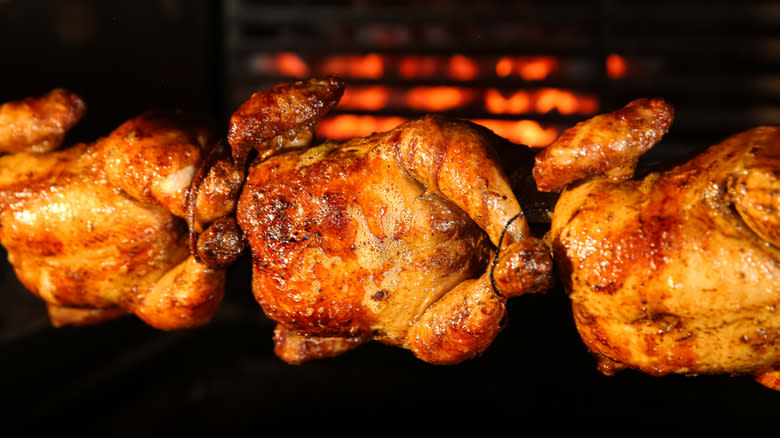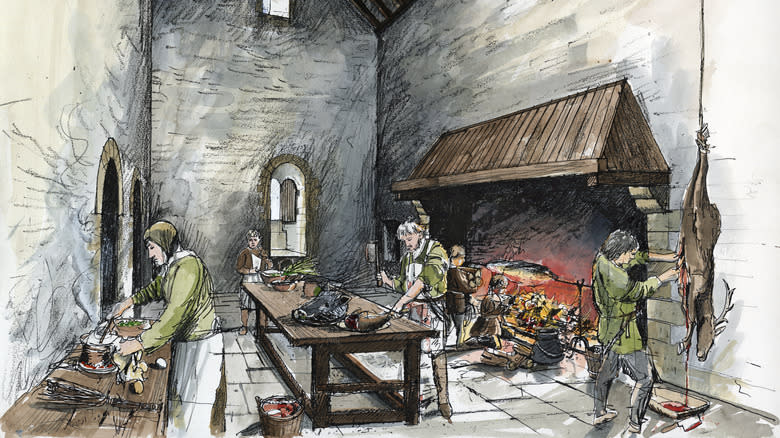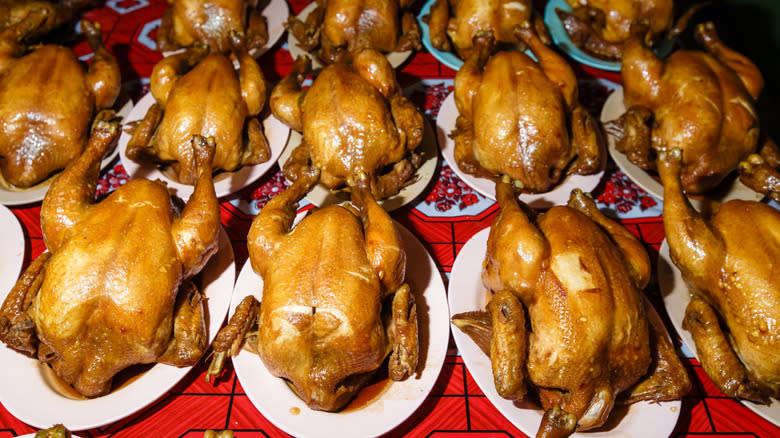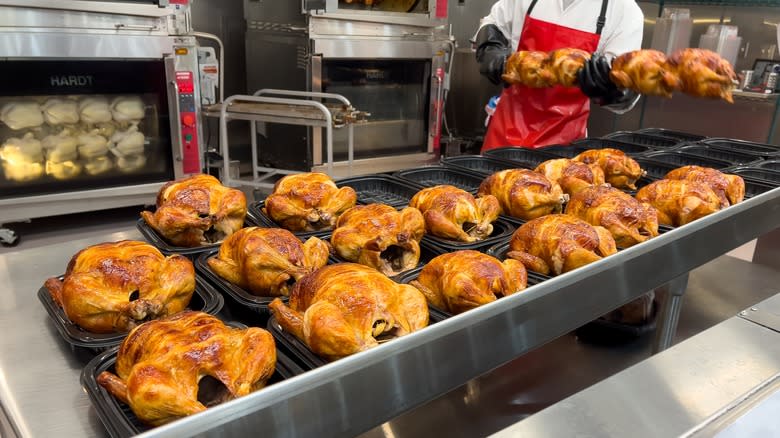From Napoleon To Costco: How Rotisserie Chicken Became So Popular

Is there a more glorious sight than spinning meat roasted over an open fire? Today, the simple rotisserie chicken can be found in just about every supermarket chain in the United States. It's an incredibly popular option meant to be picked up as a quick, easy, and delicious meal. Costco alone sold 117 million of its signature rotisserie chickens in 2022, so it's safe to say rotisserie chickens have become a staple of the American appetite.
But what you probably didn't know was that this spinning roasted chicken has had a pretty wild journey throughout history, from becoming a medieval delicacy to being Napoleon's favorite food, to finally making its way into American supermarkets.
No matter the period, one thing is certain: just about everyone enjoys digging into the crispy skin and succulent meat of a rotisserie chicken. Grab a napkin as we jump into the juicy history of the rotisserie chicken.
Read more: The Common Myths About Chicken That Are Actually False
In Medieval Times, People Turned Chicken On Spits

In medieval Europe, a spit mounted in a hearth was the preferred way to roast meats. Of course, cooks of the ring didn't have the motorized spits of today, so one (rather unlucky) person would be assigned to turn the spit for hours next to a fire or coals. Hog roasts were incredibly popular at the time. To make one, an entire hog would be attached to an iron bar and spun slowly over an open fire while a chef would baste the meat and season it with spices. But there was plenty of fowl available in medieval England, too, which meant animals like duck, goose, pheasant, partridge, swan, and, of course, chicken were roasted regularly.
However, roasted chickens were a rarer sight because they were such a dependable source of eggs, meaning only older ones that no longer laid eggs were roasted. There were several different recipes for roasted chickens, like "Chicken Endored" from around 1450, that involved a batter mixed with saffron, pepper, ginger, and salt. They were also commonly stuffed with onions, grapes, and herbs like sage or parsley. No matter how it was seasoned, medieval European cooks were some of the earliest trailblazers for rotisserie chickens.
King Richard The Lionheart Got Arrested Because He Loved Rotisserie Chicken

Way back in 1192, King Richard the Lionheart, one of the most well-known military leaders and warriors in English history, was on his way home from a Crusade in the Holy Land. He was traveling by sea but because of the stormy weather, his retinue decided to finish the journey by land. King Richard and his servants traveled in humble clothing typically worn by pilgrims, hoping that this meant they wouldn't be caught by enemies — particularly Leopold V, the Duke of Austria, whose lands they were traveling through.
However, on one fateful night, King Richard's appetite betrayed him. According to legend, he insisted on having roast chicken made for him where he was staying. However, this was a delicacy usually only made for nobles. With the delicious scent of roasted chicken and the magnificent royal ring the king was "accidentally" still wearing, locals soon put two and two together. The king was taken prisoner and handed over to Henry VI, the Holy Roman Emperor, who held Richard ransom for 150,000 marks of silver (three times England's annual income at the time). To pay for their king, all of England was heavily taxed, and the churches even had their gold and silver reserves confiscated to pay off the ransom — all reportedly because King Richard the Lionheart needed his rotisserie chicken.
Napoleon Was Said To Be Obsessed With Rotisserie Chickens

Did you know one of the greatest military commanders of all time was said to be obsessed with rotisserie chicken? That's right — Napoleon Bonaparte, celebrated conqueror and emperor, couldn't get enough of the spinning fowl. In the kitchens of his Parisian palace, chickens were constantly roasted on spits to satiate Napoleon l. In one famous instance, Napoleon went to map out an area near the Egyptian capital. The only foods he brought were three roasted chickens.
Apparently, Napoleon was usually pretty indifferent when it came to eating. He skipped many meals and ate only when hungry. But when he did eat, rotisserie chickens were a favorite. His private secretary dug deeper into Napoleon's eating habits in his memoir, writing that "his establishment was so arranged that in all places and at all hours, chicken, cutlets, and coffee might be forthcoming at a word."
Seeing how it takes a lot of food to feed an army, it's not all that surprising that Napoleon's kitchens were constantly cooking. However, he infamously didn't feed his soldiers well. While he was munching away on crispy chicken, his armies were barely eating and often had to rely on raiding villages for food.
A Struggling Chicken Farm Created An Iconic Peruvian Dish

Back in 1950, a Swiss immigrant named Roger Schuler was running a humble chicken farm just near Lima, the capital of Peru. However, business wasn't going well. He realized he had to come up with a new way to make money, and fast. That's when he came up with the idea of selling young chickens.
Schuler first marinated the chickens in a saltwater marinade. He then cooked them over Algarrobo coals, derived from a relative of the mesquite tree. Schuler effectively invented the now-legendary pollo a la brasa, otherwise known as "chicken over coals." Schuler famously put a sign on his gate that told customers they could eat as much chicken as they wanted for only five soles.
Schuler took his tasty invention to the next level when he asked a friend, Franz Ulrich, to help him build an oven to cook the chicken. Ulrich was the owner of a metal shop and came up with a unique design that placed the chickens over the hot fire on long spits. This rotisserie-like oven was named "El Rotombo." The two went on to open a renowned chicken restaurant, La Granja Azul, which is still open to this day. The legendary recipe evolved to include other ingredients, such as rosemary, huacatay (Peruvian black mint), pepper, aji panca (Peruvian red pepper), and cumin.
Parking Lot Fundraisers Led To Hawaii's Huli-Huli Chicken

One of Hawaii's iconic foods is the huli-huli chicken — delicious grilled chicken cooked over mesquite and basted with a sweet sauce that you'll find sold from carts all over the state. This style of rotisserie chicken was created back in 1955 when a former World War II naval intelligence officer named Ernest Morgado grilled up some chicken at a farmer's meeting. He basted the poultry with a teriyaki-inspired sauce his mother had given him. The result was a smoky, sweet, and sticky grilled chicken that became a hit with everyone who tried it.
He began serving the chicken at fundraisers and came up with the name by accident. The word "huli" means to turn. When Morgado would barbecue large amounts of chicken between two grills, someone yelled "Huli!" to turn the grill. The name stuck, to the point where Morgado registered it as a trademark.
Huli-huli chicken became so popular that Morgado began selling the sauce separately in 1986. The Hawaiian culinary icon even made it into the Guinness Book of World Records for hosting the largest chicken barbecue ever, serving up 46,386 portions to raise money for the Iolani School in 1981.
Boston Market Popularized The Rotisserie Chicken For Americans

Today, rotisserie chickens have become a staple of American family diets, but it wasn't always like that. We have one franchise in particular to thank for the introduction of the spinning chicken to American food culture: Boston Market.
In 1985, this little fast-casual restaurant (originally called Boston Chicken) was founded in Newtonville, Massachusetts. Growing up, cofounder Kip Kolow dined on rotisserie chickens at his local delis that were on "planetary-type carousels that would just go around and around" (via Taste). After a research trip to Europe, Kolow and business partner Arthur Cores opened the restaurant using a unique roasting oven that stacked seven spits, holding five chickens each. Each spit rotated, allowing the chickens to deposit drippings onto the birds below, resulting in incredibly flavorful meat and crispy skin.
This technique was a huge success. The rotisserie chickens were marketed as on-the-go convenience meals that introduced the American public to the tasty world of rotisserie chickens. Thanks to Boston Market, we even celebrate National Rotisserie Chicken Day on June 2 every year.
Rotisserie Chickens Became A Staple Of American Supermarkets

After the rotisserie chicken was introduced to the American public, there was no turning back. By 1994, grocery chains Costco and Kroger started selling rotisserie chickens. By 1998, Albertsons, Safeway, and several other groceries joined the trend. Families understood the importance of the already deliciously cooked bird waiting for them at the store. They could pick up a meal for cheap, have it on the table with little to no effort, and even use the carcass to create a hearty broth for a future meal. By 2017, an estimated half of Americans bought a rotisserie chicken, while in 2020, 625 million rotisserie chickens were sold in the U.S.
Supermarkets famously keep the price of these chickens very low and often consider them a "loss leader" — a product that doesn't make money but brings customers in so they buy other things. But with the skyrocketing success of ready-made meals, supermarkets began to invest even more heavily in the roasted chicken side of their business. Groceries sometimes use tricks to get customers to buy more, like placing more profitable side dishes next to the chickens. But who can complain when you're paying less than 5 bucks for a full meal?
Costco Sells More Than 100 Million Rotisserie Chickens A Year

Although you can find rotisserie chickens at most supermarkets today, Costco has become synonymous with well-priced roasted chicken. When it began selling its three-pound chickens to the public, they were priced at $4.99. About two decades later, they still cost $4.99. Even with record-high inflation and the rising costs of poultry, Costco has never touched the price tag for its best-selling chickens, though, adjusting for inflation, the chicken should be selling for $8.31. You probably can't roast a chicken on your own for less money, so how does Costco do it efficiently?
The answer: it isn't. Costco has publically called the pre-cooked chicken a loss leader that's meant to bring in more customers, a strategy that's reportedly paid off. With over 100 million chickens sold every year, you can assume shoppers are buying a lot more than just rotisserie chicken when they get to the megastore. If you've ever purchased one of these signature birds, you've probably noticed they are practically always located in the very back of the warehouse. As a result, customers must pass several aisles along the way.
Costco means serious business when it comes to rotisserie chickens. The company even invested in a 432-acre poultry plant in Nebraska that can produce more than one million rotisserie birds every week, saving them 35 cents per chicken. This made Costco one of the first major businesses to control its entire chicken supply chain.
An Internet Sensation Ate 40 Rotisserie Chickens In 40 Days

If you haven't gotten the picture yet, Americans love their rotisserie chicken. This idea can best be summarized by internet sensation Alexander Tominsky, who is probably better known as the "Rotisserie Chicken Guy." The Philadelphia steakhouse server became an overnight celebrity and local icon when he decided to eat a whole rotisserie chicken, every single day, for 40 days straight. He posted his progress on Twitter, where followers witnessed him become progressively less excited about his daily meal.
How did the challenge start? He told Interview that, one day before work, he felt a bit of hunger. "So I got a rotisserie chicken and as soon as I started to consume, I had this immediate feeling that there's something powerful about it. Some sort of — I just felt really good about it. So then I just kept taking pictures and eating one every single day and it wasn't until day 11 that I decided to start sharing it with the world because I felt like it was too powerful to keep bottled up."
Apparently, it really was as powerful as Tominsky thought. He racked up over 40,000 followers on Twitter and even became a Philly hero, with hundreds cheering him as he consumed his 40th and final chicken. Tominsky turned rotisserie chicken into something even more special than a simple takeaway meal — for some, it became no less than an icon of courage, heart, and unity.
Read the original article on Mashed.

